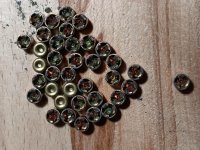Been handloading over 50 years and have never encountered anything like this.
While practicing for next Saturday's match, I experienced several misfires. Odd. Opening the cylinder was difficult due to the struck primer being backed out.
The details:
38 Special, 160 Bayou round nose coated.
3.5 grains Bullseye, chronographed at 755 FPS.
Federal SP match primers.
SD: 8.15, good load, used it for years.
Brass: R-P 38 Spl +P
Gun 67-3.
Brass sorted from a recently purchased a large lot of fired brass. Being OCD, I sort everything by headstamp.
First time I loaded these.
Primed using an RCBS hand tool, ensuring each is fully seated.
After the first happening, I double checked each cylinder load.
Only thing I can imagine was some loose primer pockets.
Would appreciate any and all thoughts on this.
I will discard all these cases.
While practicing for next Saturday's match, I experienced several misfires. Odd. Opening the cylinder was difficult due to the struck primer being backed out.
The details:
38 Special, 160 Bayou round nose coated.
3.5 grains Bullseye, chronographed at 755 FPS.
Federal SP match primers.
SD: 8.15, good load, used it for years.
Brass: R-P 38 Spl +P
Gun 67-3.
Brass sorted from a recently purchased a large lot of fired brass. Being OCD, I sort everything by headstamp.
First time I loaded these.
Primed using an RCBS hand tool, ensuring each is fully seated.
After the first happening, I double checked each cylinder load.
Only thing I can imagine was some loose primer pockets.
Would appreciate any and all thoughts on this.
I will discard all these cases.

